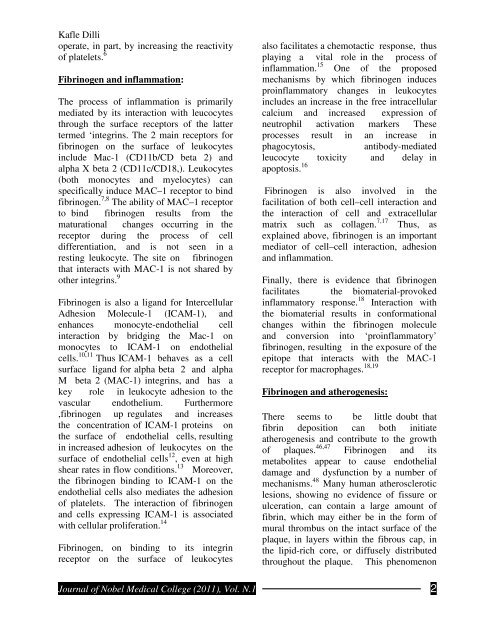Journal of - Nobel Medical College
Journal of - Nobel Medical College
Journal of - Nobel Medical College
You also want an ePaper? Increase the reach of your titles
YUMPU automatically turns print PDFs into web optimized ePapers that Google loves.
Kafle Dillioperate, in part, by increasing the reactivity<strong>of</strong> platelets. 6Fibrinogen and inflammation:The process <strong>of</strong> inflammation is primarilymediated by its interaction with leucocytesthrough the surface receptors <strong>of</strong> the lattertermed ‘integrins. The 2 main receptors forfibrinogen on the surface <strong>of</strong> leukocytesinclude Mac-1 (CD11b/CD beta 2) andalpha X beta 2 (CD11c/CD18,). Leukocytes(both monocytes and myelocytes) canspecifically induce MAC–1 receptor to bindfibrinogen. 7,8 The ability <strong>of</strong> MAC–1 receptorto bind fibrinogen results from thematurational changes occurring in thereceptor during the process <strong>of</strong> celldifferentiation, and is not seen in aresting leukocyte. The site on fibrinogenthat interacts with MAC-1 is not shared byother integrins. 9Fibrinogen is also a ligand for IntercellularAdhesion Molecule-1 (ICAM-1), andenhances monocyte-endothelial cellinteraction by bridging the Mac-1 onmonocytes to ICAM-1 on endothelialcells. 10,11 Thus ICAM-1 behaves as a cellsurface ligand for alpha beta 2 and alphaM beta 2 (MAC-1) integrins, and has akey role in leukocyte adhesion to thevascular endothelium. Furthermore,fibrinogen up regulates and increasesthe concentration <strong>of</strong> ICAM-1 proteins onthe surface <strong>of</strong> endothelial cells, resultingin increased adhesion <strong>of</strong> leukocytes on thesurface <strong>of</strong> endothelial cells 12 , even at highshear rates in flow conditions. 13 Moreover,the fibrinogen binding to ICAM-1 on theendothelial cells also mediates the adhesion<strong>of</strong> platelets. The interaction <strong>of</strong> fibrinogenand cells expressing ICAM-1 is associatedwith cellular proliferation. 14Fibrinogen, on binding to its integrinreceptor on the surface <strong>of</strong> leukocytesalso facilitates a chemotactic response, thusplaying a vital role in the process <strong>of</strong>inflammation. 15 One <strong>of</strong> the proposedmechanisms by which fibrinogen inducesproinflammatory changes in leukocytesincludes an increase in the free intracellularcalcium and increased expression <strong>of</strong>neutrophil activation markers Theseprocesses result in an increase inphagocytosis,antibody-mediatedleucocyte toxicity and delay inapoptosis. 16Fibrinogen is also involved in thefacilitation <strong>of</strong> both cell–cell interaction andthe interaction <strong>of</strong> cell and extracellularmatrix such as collagen. 7,17 Thus, asexplained above, fibrinogen is an importantmediator <strong>of</strong> cell–cell interaction, adhesionand inflammation.Finally, there is evidence that fibrinogenfacilitates the biomaterial-provokedinflammatory response. 18 Interaction withthe biomaterial results in conformationalchanges within the fibrinogen moleculeand conversion into ‘proinflammatory’fibrinogen, resulting in the exposure <strong>of</strong> theepitope that interacts with the MAC-1receptor for macrophages. 18,19Fibrinogen and atherogenesis:There seems to be little doubt thatfibrin deposition can both initiateatherogenesis and contribute to the growth<strong>of</strong> plaques. 46,47 Fibrinogen and itsmetabolites appear to cause endothelialdamage and dysfunction by a number <strong>of</strong>mechanisms. 48 Many human atheroscleroticlesions, showing no evidence <strong>of</strong> fissure orulceration, can contain a large amount <strong>of</strong>fibrin, which may either be in the form <strong>of</strong>mural thrombus on the intact surface <strong>of</strong> theplaque, in layers within the fibrous cap, inthe lipid-rich core, or diffusely distributedthroughout the plaque. This phenomenon<strong>Journal</strong> <strong>of</strong> <strong>Nobel</strong> <strong>Medical</strong> <strong>College</strong> (2011), Vol. N.1 2


